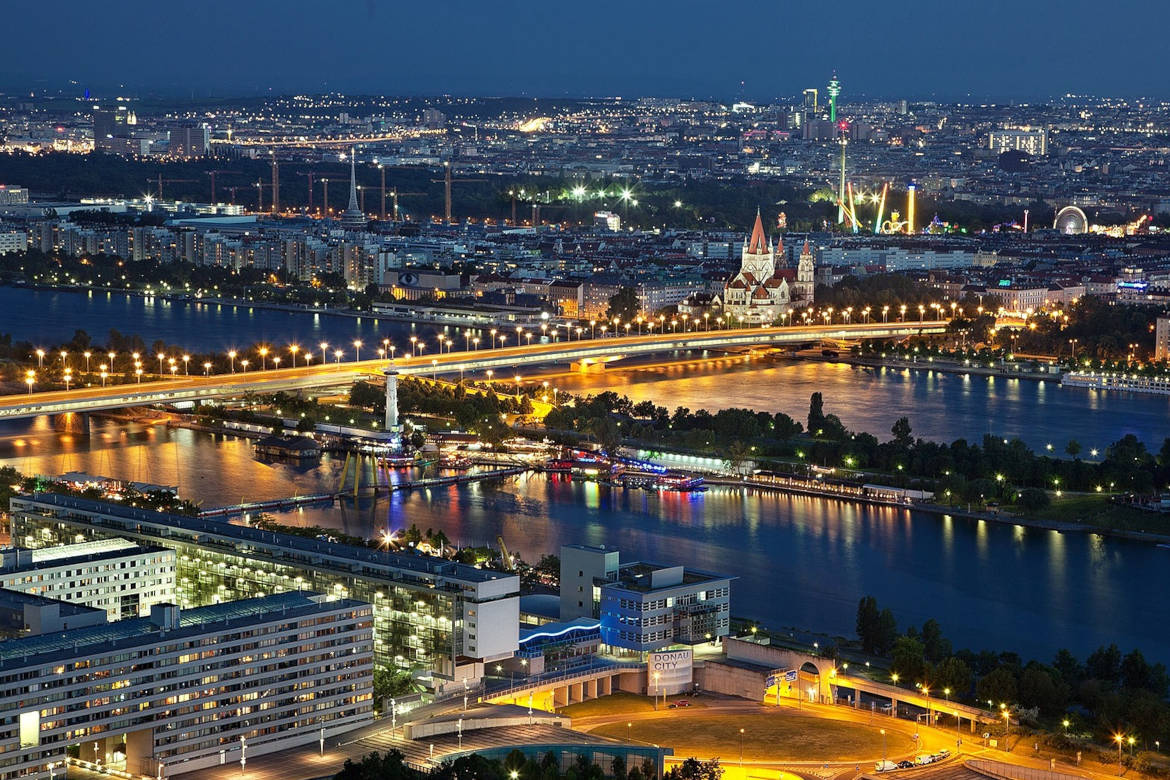Donauinsel (Danube Island) is Austria’s largest island and a must-visit destination for travelers exploring Vienna. As Austria is a landlocked country with no coastline, this remarkable 21-kilometer (13-mile)-long island offers a rare waterside escape.
Located in the heart of Vienna, Donauinsel is one of Europe’s most fascinating urban green spaces, featuring a unique history, stunning landscapes, diverse culinary offerings, and a vibrant festival scene.
Table of Contents
Geography: A Man-Made Wonder
Donauinsel stretches between two branches of the Danube River, forming a narrow strip of land that serves as both a flood defense system and a recreational paradise.
Covering an area of almost 4 square kilometers (1.5 square miles), it separates the main Danube River from the New Danube, a parallel water channel constructed in the 1970s to protect Vienna from flooding.
Despite its artificial origins, Austria’s largest island now feels like a natural retreat, featuring lush meadows, sandy beaches, quiet coves, and even vineyards.
With 70 kilometers (43 miles) of cycling and hiking trails, Donauinsel offers unparalleled opportunities for outdoor activities right within Vienna’s city limits.
Comparison of Five Notable European River Islands
| Island | Country | Area (km²) | Area (sq mi) | River |
|---|---|---|---|---|
| Donauinsel | Austria | 3.9 | 1.5 | Danube |
| Île aux Cygnes | France | 0.013 | 0.0050 | Seine |
| Île de la Cité | France | 0.22 | 0.085 | Seine |
| Khortytsia | Ukraine | 23.59 | 9.11 | Dnieper |
| Margit-sziget | Hungary | 0.965 | 0.373 | Danube |
History: From Flood Defense to Leisure Haven
The history of Donauinsel is deeply intertwined with Vienna’s relationship with the Danube. For centuries, the river posed a flood threat to the city, prompting numerous engineering projects.
In the 1970s, authorities devised a large-scale solution: digging a new channel to divert floodwaters and using the excavated material to create an island.
Though its initial purpose was purely practical, Donauinsel quickly became a beloved recreational spot. Over the decades, Vienna transformed this former flood barrier into an urban oasis, adding beaches, sports facilities, and cultural venues.
Today, Donauinsel is a hub for relaxation, exercise, and entertainment, drawing millions of visitors each year.
Culinary Delights: From Heurigen to International Flavors
Visitors will find plenty to savor on Donauinsel. Traditional Austrian cuisine thrives here, with rustic “Heurigen” wine taverns offering local specialties such as Wiener Schnitzel, Brettljause (a platter of cold cuts and cheese), and freshly baked pretzels.
These establishments often serve young Viennese wines, a perfect refreshment after a long walk or bike ride.
In addition to Austrian fare, the island hosts a diverse array of international food stalls, especially during the annual Donauinselfest. From Balkan grilled meats to Turkish kebabs and Asian street food, there’s something to satisfy every palate.
For a more relaxed experience, many visitors opt for a picnic, bringing local delicacies from Vienna’s famous markets, such as Naschmarkt or Karmelitermarkt.
How to Get to Austria’s Largest Island
Reaching Donauinsel is effortless, thanks to Vienna’s efficient public transportation network. The U1 and U6 metro lines both stop at stations on or near the island, including Donauinsel Station (U1) and Neue Donau Station (U6).
Trams and buses also serve the surrounding areas, making it accessible from all parts of the city. For those preferring an active approach, cycling is a fantastic option.
The island is connected to Vienna’s extensive bike path system, allowing for a scenic ride along the Danube. Alternatively, visitors arriving by car can find parking facilities near key entry points. In the summer, ferries occasionally operate along the river, offering a picturesque way to arrive.
When to Visit Donauinsel
The largest island in Austria is a year-round destination, but each season offers a distinct experience.
Summer is undoubtedly the peak time, with warm temperatures inviting visitors to swim, sunbathe, and enjoy water sports like kayaking and stand-up paddleboarding. This is also when the legendary Donauinselfest takes place, drawing music lovers from across Europe for three days of free concerts.
Spring and autumn provide a quieter, more nature-focused experience. These seasons are ideal for cycling, hiking, or simply enjoying the fresh air amid colorful foliage. Birdwatchers will find migratory species along the island’s wetlands, making it a rewarding time for wildlife enthusiasts.
Winter, though less popular, has its own charm. Snow-covered paths create a peaceful atmosphere for long walks, while the frozen Danube (when conditions allow) offers an unusual backdrop for photography. Despite fewer visitors, locals still frequent the island for jogging and dog walking.
Why Visit the Largest Island in Austria
Donauinsel’s appeal lies in its versatility. Nature lovers can explore its diverse ecosystems, from wildflower meadows to dense forests, while fitness enthusiasts can take advantage of the island’s extensive sports facilities.
Families appreciate the playgrounds, picnic areas, and calm swimming spots, while thrill-seekers can try windsurfing or wakeboarding at the water sports center.
Culturally, Donauinsel is home to the Donauinselfest, Europe’s largest free open-air music festival, featuring international and Austrian artists across multiple genres.
This massive event attracts millions and showcases Vienna’s vibrant arts scene. For those seeking tranquility, the island’s lesser-known corners offer quiet escapes, far removed from the bustling city.
Whether you’re sipping wine at a riverside tavern, watching the sunset over the Danube, or cycling through serene landscapes, Donauinsel provides an unparalleled mix of urban energy and natural beauty.
